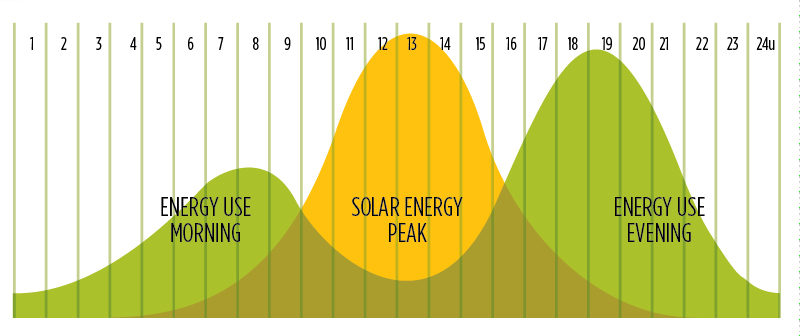What is home battery storage?
Solar panels mainly generate energy during the day when most members of the household are out. In that case, the generated solar energy is fed into the electricity grid. And when people get home in the evening, they cook, turn on the washing machine and so on. The power this requires comes from the electricity grid and is far more expensive than what the self-generated solar energy has yielded. It is therefore a good idea to store the solar energy generated during the day in a battery, so it can be used whenever the occupiers need it.

How does home battery storage work?
Home battery storage uses a battery, an inverter/charger and an energy meter. The solar energy that is generated during the day primarily goes to the home's electrical appliances. These are all the devices that require power. If the generated solar energy exceeds the used energy, it is stored in the battery. The home battery helps you use as little energy from the grid as possible. The energy stored in the battery is used on overcast days or at night. In that case, the energy from the grid is only used when there is no solar energy available and the battery is empty.
What are the benefits?
On average, solar panel owners use only 30% of the renewable energy they generate. A battery system can easily push this percentage up to 60 or 70%. It allows them to use less energy from the grid, which is often generated at environmentally unfriendly power plants.
A home battery can also be used as an uninterruptible power supply or UPS. You can choose to keep your battery charged at a certain percentage at all times. This means that when you have a power cut, the backup system will kick in and the battery will supply the necessary power.
Is home battery storage cost-effective?
Now that meters that run backwards have been abolished in Flanders, solar panel owners with digital meters are taxed on their actual electricity consumption from the grid. For example, solar panel owners receive 9 euro cents per kWh of solar energy they feed into the grid, but pay 29 euro cents for the energy they consume from the grid. In such cases, a battery system is cost-effective. The Flemish government does provide a subsidy per kilowatt hour until the end of 2024. More information about this subsidy is available here.
What is the capacity charge?
From 1 January 2022, grid charges in Flanders will be largely based on capacity. You pay a fixed amount for an energy consumption of up to 2.5 kWh, but a supplement is charged as soon as you use more. This means that you will pay more for peaks in power consumption. Such peaks happen when you charge your electric car, you turn on your heat pump or you use several electrical appliances at the same time, such as a cooker, a washing machine and a tumble dryer. It is therefore important not to switch on any power-hungry appliances at the same time and to spread their use over time. A home battery will also help in this regard, as it will help to absorb such peaks. There are therefore plenty of reasons to buy a home battery, as it allows you to use as much of your self-generated solar energy as possible rather than let it go to waste.
